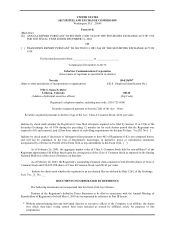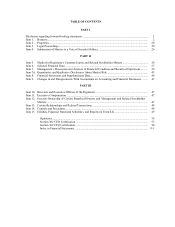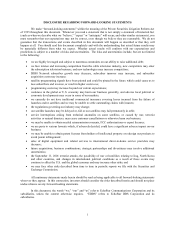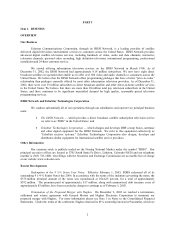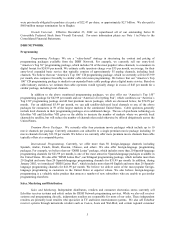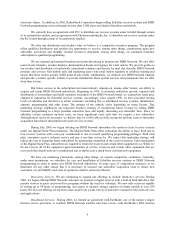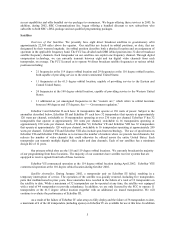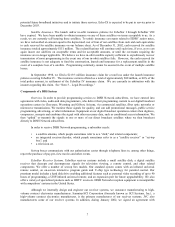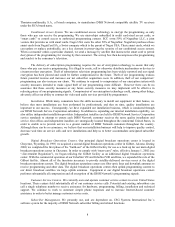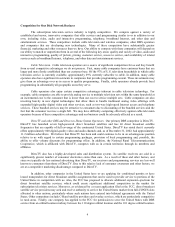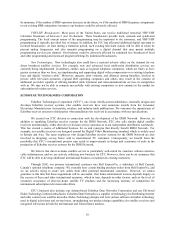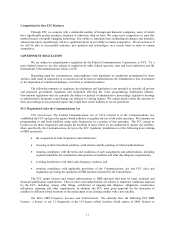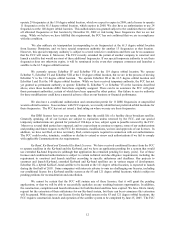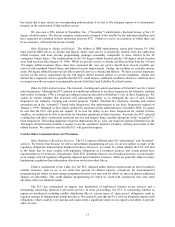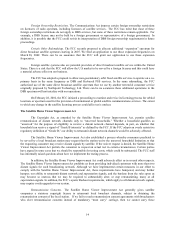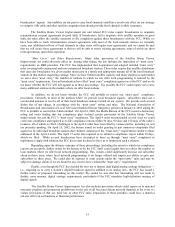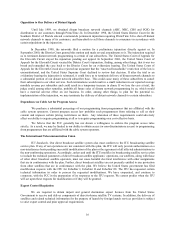Dish Network 2002 Annual Report Download - page 8
Download and view the complete annual report
Please find page 8 of the 2002 Dish Network annual report below. You can navigate through the pages in the report by either clicking on the pages listed below, or by using the keyword search tool below to find specific information within the annual report.6
to transponder and solar array failures, EchoStar IV experienced anomalies affecting its thermal systems and propulsion
system. Consequently, the estimated total remaining useful life of EchoStar IV is two to three years. There can be no
assurance that further material degradation, or total loss of use, of EchoStar IV will not occur in the immediate future.
Currently no programming is being transmitted to customers on EchoStar IV, and the satellite functions as an in-orbit
spare.
During 2000 and 2001, EchoStar V experienced anomalies resulting in the loss of two solar array strings, and
during August 2002, EchoStar V experienced anomalies resulting in the loss of an additional solar array string. The
satellite has a total of approximately 96 solar array strings and approximately 92 are required to assure full power
availability for the estimated 12-year design life of the satellite. In addition, during January 2003, EchoStar V
experienced an anomaly in a spacecraft electronic component which affects the ability to receive telemetry from certain
on-board equipment. Other methods of communication have been established to alleviate the effects of the failed
component. An investigation of the solar array and electronic component anomalies, none of which have impacted
commercial operation of the satellite, is continuing. Until the root cause of these anomalies is finally determined, there
can be no assurance future anomalies will not cause further losses which could impact commercial operation of the
satellite.
During 2001, EchoStar VI experienced anomalies resulting in the loss of two solar array strings, and during
July 2002, EchoStar VI experienced anomalies resulting in the loss of an additional solar array string. The satellite has
a total of approximately 112 solar array strings and approximately 106 are required to assure full power availability for
the estimated 12-year design life of the satellite. An investigation of the solar array anomalies, none of which have
impacted commercial operation of the satellite, is continuing. Until the root cause of these anomalies is finally
determined, there can be no assurance future anomalies will not cause further losses which could impact commercial
operation of the satellite.
During September and October 2002, two of the thrusters on EchoStar VIII experienced anomalous events
and are not currently in use. The satellite is equipped with a total of 12 thrusters that help control spacecraft location,
attitude, and pointing and is currently operating using a combination of the other 10 thrusters. This workaround
requires more frequent maneuvers to maintain the satellite at its specified orbital location, which are less efficient and
therefore result in accelerated fuel use. In addition, the workaround will require certain gyroscopes to be utilized for
aggregate periods of time in excess of their originally qualified limits. However, neither of these workarounds are
expected to significantly reduce the estimated 12-year design life of the satellite. An investigation of the thruster
anomalies including the development of additional workarounds for long term operations is continuing. None of these
events has impacted commercial operation of the satellite to date. Until the root cause of these anomalies has been
finally determined, there can be no assurance future anomalies will not cause further losses which could impact
commercial operation of the satellite.
Certain Risks to Our Satellites. Meteoroid events pose a potential threat to all in orbit geosynchronous
satellites including EchoStar’s DBS satellites. While the probability that our satellites will be damaged by
meteoroids is very small, that probability increases significantly when the Earth passes through the particulate
stream left behind by various comets.
Occasionally, increased solar activity poses a potential threat to all in-orbit geosynchronous satellites
including EchoStar’s direct broadcast satellites. The probability that the effects from this activity will damage our
satellites or cause service interruptions is generally very small.
Some decommissioned spacecraft are in uncontrolled orbits which pass through the geostationary belt at
various points, and present hazards to operational spacecraft including EchoStar’s direct broadcast satellites. The
locations of these hazards are generally well known and may require EchoStar to perform maneuvers to avoid
collisions.
Satellites under Construction. EchoStar IX, which is expected to operate at the 121 degree orbital location,
is being manufactured by Space Systems/Loral. EchoStar IX will be capable of operating 32 Ku-band transponders
at 110 watts each, in addition to a Ka-band payload. EchoStar IX is currently expected to be used for expanded
DISH Network service such as video and other services. The Ka-band portion will be used to test and verify

